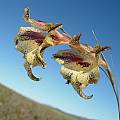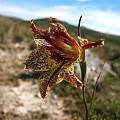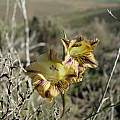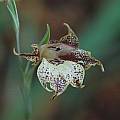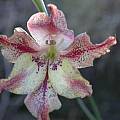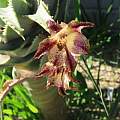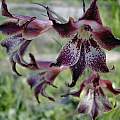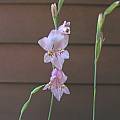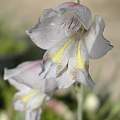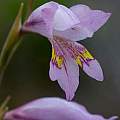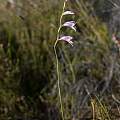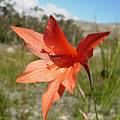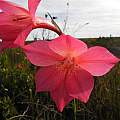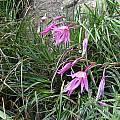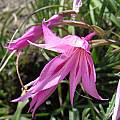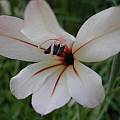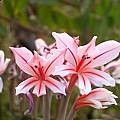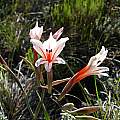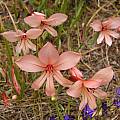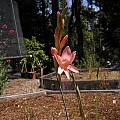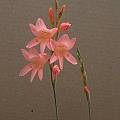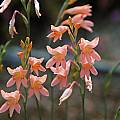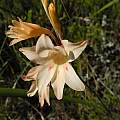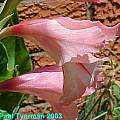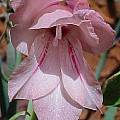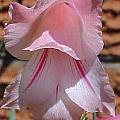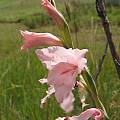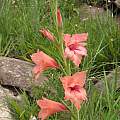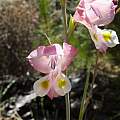From pale rose and mauve to salmon to screaming pink, this color complex offers many shades and the widest range of species in the color indices.
Page 1: G. anatolicus... Page 2: G. carmineus... Page 3: G. densiflorus... Page 4: G. gracilis... Page 6: G. nigromontanus... Page 7: G. phoenix... Page 8: G. saxatilis... Page 9: G. vernus...
Gladiolus maculatus Sweet extends across the southern coast and immediate interior of the winter rainfall area to the Eastern Cape where it is often found growing in heavy soils in renosterveld. Flowers are dull yellow to lilac and speckled with brown or purplish spots. They are long-tubed and fragrant during the day and the evening. The first three pictures were taken by Cameron McMaster near Napier and Bredasdorp in the Overberg.
The first two pictures below are of garden flowers taken by Mary Sue Ittner December 2007 and January 2009. The next two were taken by Alan Horstmann and the last by Dirk Wallace.
Gladiolus martleyi L.Bolus syn. Gladiolus pillansii grows on sandy and rocky flats in the northern and southwestern Cape and blooms in the fall on a flowering stalk without leaves. Growing from 30 to 60 cm, it has usually scented pale to pink or lilac flowers. The lower lateral tepals each have a transverse band or a spear shaped yellow mark edged darker pink or purple in the upper half. The first photo by Bob Rutemoeller shows one grown from IBSA seed from Betty's Bay. The second photo was taken by Dirk Wallace. Other photos taken by Christopher Whitehouse in the Phillipskop Mountain Reserve.
Gladiolus meridionalis G.J.Lewis is found in the Southern Cape from the Overberg to Port Elizabeth (both winter and summer rainfall areas) and flowers from June to August. The distribution is discontinuous. Plants grow in stony sandstone soils in low fynbos on mountain slopes and flats that are usually in sight of the ocean. The populations in the west of the range have dark pink to salmon flowers and those in the east have cream to pinkish orange flowers. Flowers are adapted for pollination by sunbirds with a long perianth tube. An article here describes a rare finding of this species. The first photograph from Cameron McMaster was taken on the farm Fairfield in the Napier district where it occurs on sandstone slopes. The second photo was taken by Rachel Saunders.
Gladiolus microcarpus is endemic to the Drakensberg in KwaZulu-Natal, the Free State, South Africa and Lesotho. Plants grow on rocks and steep cliffs where their stems hang downward from vertical rock faces and their stems are anchored in crevices. During the growing season the habitat is moist. Flowers are bright pink with a broad white longitudinal zone in the lower two thirds of the lower three tepals and a narrow reddish purple streak in the midline. Photos taken by Cameron McMaster at Sentinel Peak, February 2008.
Gladiolus miniatus is found on coastal limestone outcrops from Hermanus to Agulhas. Spring blooming flowers are salmon with red along the midline. The first photo was taken by Dirk Wallace and the second and third by Cameron McMaster at Arniston. The last two photos were taken by Mary Sue Ittner in May 2005 when they were blooming for the first time from seed in Northern California with California bulb companions Brodiaea jolonensis, Allium unifolium and Triteleia hyacinthina in bloom in the same raised bed.
Gladiolus monticola is found on rocky sandstone slopes in the southwestern Cape. There are populations on Table Mountain. It has pink to apricot flowers with darker pink markings on the lower tepals and blooms summer into fall before the single leaf is produced. The first two photos by Bob Rutemoeller. This first photo shows it as the only bulb blooming in one of our raised beds that only has bulbs from winter rainfall areas, blooming in July 2003 in the northern hemisphere. The leaf in the picture is of another Gladiolus that bloomed a month earlier. In the second photo we put cardboard behind the flowers to get the close-up that shows the details better. The third photo was taken years later by Mary Sue Ittner. The last photo from Rachel Saunders was taken on Table Mountain February 2011.
Gladiolus mortonius (formerly Gladiolus ochroleucus var. macowanii) is a summer rainfall Eastern Cape species that grows in open stony grassland. Although it resembles Gladiolus ochroleucus, the long tubed pink flowers with a red median streak on the lower tepals and a few reddish longitudinal lines parallel are much larger (tube is 30-45 mm). It is a gorgeous little gladiolus that grows successfully in a pot, producing flower stems around 8-9 inches tall, with comparatively large flowers that face slightly downwards. The photo (face) is taken upwards into the flower to show detail. This has had a succession of flowers since late February (in Australia) and is now sending up another spike in mid April just as the last of the previous flowers have faded. The first three photos by Paul Tyerman.
The photos below were taken in the Eastern Cape by Cameron McMaster February 2008. The first was taken at Andriesberg and the last two at Cathcart.
Gladiolus mostertiae is found in wet sandy soils in the Bokkeveld Mountains in the Northwest Cape. Growing 25 to 30 cm high, this species has linear leaves with a thickened midrib and pale pink flowers with yellow-green markings on the lower tepals. It flowers November to December. Photo taken by Rachel Saunders November 2013 near Nieuwoudtville in a year with late rainfall so the soil was still wet when it bloomed.
Page 1: G. anatolicus... Page 2: G. carmineus... Page 3: G. densiflorus... Page 4: G. gracilis... Page 6: G. nigromontanus... Page 7: G. phoenix... Page 8: G. saxatilis... Page 9: G. vernus...
